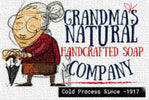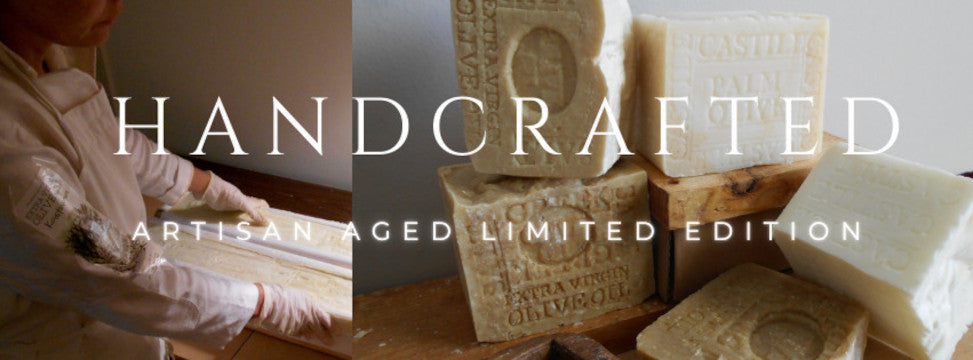Handmade soap is a blend of science and art. Creators combine oils, lye, water, and additives like herbs, essential oils, or natural colorants to produce unique bars.
Platforms like Etsy, Pinterest, and Facebook showcase a vibrant community of soap artisans who craft visually stunning products, often with intricate designs, vibrant colors, and personalized scents. These soaps are marketed for their natural ingredients, eco-friendliness, and the personal touch of being handcrafted, appealing to consumers seeking alternatives to mass-produced products.

Handmade soap artisan from GRANDMA’S NATURAL HANDCRAFTED SOAP
-
Diversity of Creations: A quick search on Etsy reveals thousands of listings, from minimalist goat milk soaps to elaborate swirl-patterned bars resembling works of art. Artisans often share their process on social media, with Instagram and YouTube tutorials showing techniques like cold process, hot process, or melt-and-pour.

Community & Culture:
- Facebook groups like “Soap Making” or “Handmade Soapmakers Guild” foster communities where makers exchange tips, troubleshoot issues, and celebrate successes. These spaces highlight the passion and dedication behind each bar.
The Imperfection of the Craft The second part of your prompt—“not every soap we make turns out the way we envisioned it”—speaks to the challenges and unpredictability of soapmaking. This imperfection is a universal experience for artisans and a key aspect of the handmade ethos.
Common Issues:
- Aesthetic Flaws: Soap may crack, develop soda ash (a white powdery film), or have uneven color swirls due to factors like temperature, ingredient ratios, or humidity.
- Scent Fading: Essential oils can lose potency during the saponification process, leading to weaker-than-expected fragrances.
- Texture Problems: Overheating or improper mixing can cause grainy or lumpy textures, while air bubbles may form if the batter isn’t poured carefully.
- Failed Experiments: Trying new techniques, like layering or embedding objects, can lead to unexpected results, such as colors bleeding or layers not adhering.
- Learning Curve: Soapmaking requires mastering chemical reactions (saponification) and artistic techniques. Beginners often face mishaps, like seized soap (where the mixture hardens too quickly) or lye-heavy bars that are unsafe for use. Even experienced makers encounter occasional flops, as noted in blog posts on sites like Soap Queen or Lovin Soap Studio, where artisans share “soap fails” as part of the learning process.
- Embracing Imperfection: Many artisans view these imperfections as part of the charm. A slightly off-color bar or an unexpected swirl can still be functional and beautiful. Some even repurpose “ugly” soaps into new batches or sell them at a discount, emphasizing sustainability. This aligns with the broader handmade movement, which values authenticity over mass-produced perfection.
Cultural & Market Context
- The handmade soap market thrives on the appeal of individuality and ethical production. Consumers are drawn to small-batch products that avoid synthetic chemicals, palm oil, or plastic packaging, as seen in trends on Etsy and posts on X highlighting “zero-waste” or “vegan” soaps. However, the saturation of the market—thousands of sellers on Etsy alone—means artisans must differentiate themselves through unique branding, storytelling, or innovative designs.
Challenges for Artisans: Beyond crafting, makers face business hurdles like sourcing sustainable ingredients, managing costs, and competing in a crowded market. The emotional toll of a failed batch can be significant, especially for small-scale creators who invest time and resources into each bar.
Consumer Perception: Buyers often appreciate the “human” element of handmade goods, including minor imperfections. Artisans who share their process transparently, through social media or blog posts about failed batches, build trust and relatability with their audience.
Connecting to Broader Themes This theme resonates with broader ideas of creativity, resilience, and the beauty of imperfection, akin to the Japanese philosophy of wabi-sabi (finding beauty in the imperfect). Despite setbacks, it also reflects the entrepreneurial spirit of small-scale makers who turn passion into a livelihood.
The handmade soap community exemplifies how failure is a stepping stone to mastery, as artisans iterate and improve with each batch.
If you’d like me to dive deeper into a specific aspect—like soapmaking techniques, market trends, or how artisans handle “failed” batches—let me know! Alternatively, I can search X or the web for real-time examples of soapmakers discussing their craft or analyze a specific Etsy listing or Facebook group for more context.



0 comments